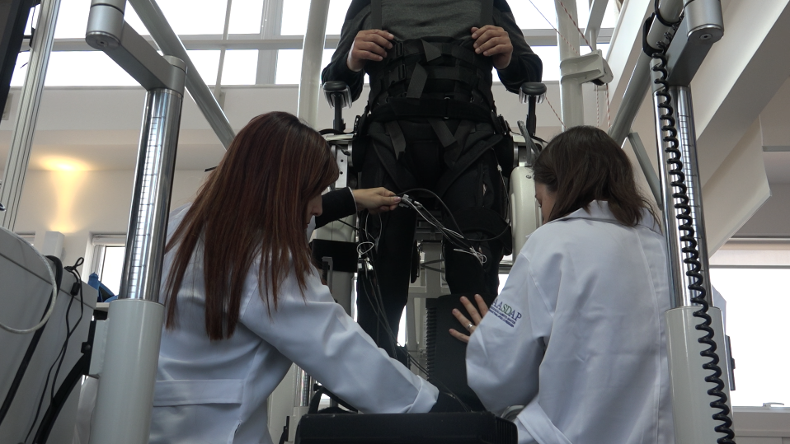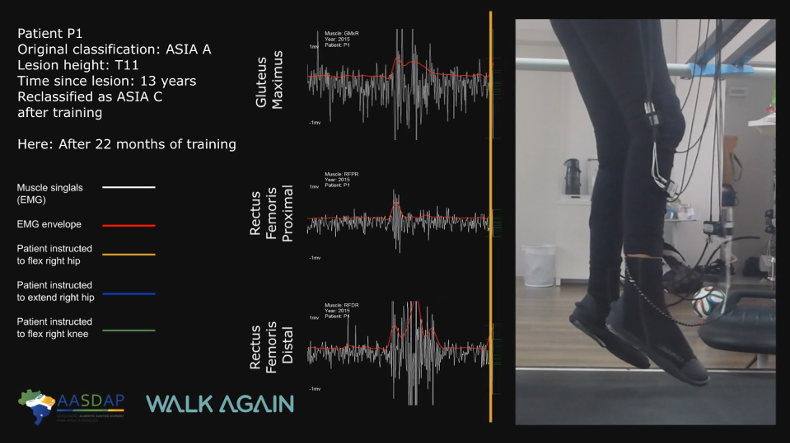11/08/2016
By Ariane Mondo – Ascom ISD, with information from AASDAP
Photos: AASDAP Disclosure
On June 12, 2014, the Walking Again Project, an international non-profit scientific consortium, carried out a first-of-its-kind scientific demonstration during the opening ceremony of the Football World Cup in Brazil. On this occasion, a young Brazilian, with almost two-thirds of his body paralyzed, launched the opening kick of the World Cup, using a brain-machine interface that allowed him to control the movements of an exoskeleton of his lower limbs, while he received feedback signals. tactile feel of this robot's feet.

Two years after that public demonstration, the consortium publishes its first clinical work, describing the findings obtained during the first 12 months of training eight chronic paraplegic patients, from January to December 2014. Edmond and Lily Safra International Institute of Neuroscience (IIN-ELS), one of the units of the Santos Dumont Institute (ISD) located in Macaíba (RN), is part of the international team that participated in this clinical study, made up of neuroscientists, engineers and a multidisciplinary rehabilitation team.
The study published on August 11, 2016 in the English scientific journal Scientific Reports (article link in English HERE) reports the discovery that the group of patients who continued to train with systems controlled by brain activity, including a motorized exoskeleton, were able to reacquire the ability to voluntarily move some leg muscles and feel sensations of touch, pain, proprioception and vibration emanating from paralyzed limbs.
This partial recovery occurred despite these patients having been clinically diagnosed with a complete spinal cord injury, in some cases more than a decade ago. The patients also recovered an important degree of intestinal peristaltic movements and bladder emptying control and demonstrated a significant improvement in their cardiovascular functions, which in one case resulted in a significant reduction in the initial degree of hypertension.
Based on these findings, this is the first study to report the occurrence of partial neurological recovery in patients with spinal cord injuries that led to complete paraplegia, as a result of a long period (12 months) of rehabilitation based on the use of brain-machine interfaces. (ICMs).
Edgard Morya, research coordinator at IIN-ELS, reports that initial tests began in Macaíba at the beginning of the Andar de Novo project, in 2013. He also states that IIN-ELS collaborated with the first development tests for integration of the brain-machine interface, virtual reality and robotic gait.
Brain reorganization

In light of these surprising results, the Andar Again Project scientists hypothesize that the long-term training regimen likely promoted a process of functional brain reorganization that reactivated nerves that had survived the original spinal cord injury but had remained dormant ever since.
The team of researchers, led by Miguel Nicolelis, director of the Neuroengineering Center at Duke University (USA), scientific coordinator of the Andar de Novo Project and President of the ISD Board of Directors, says that the limit of the surprising clinical recovery observed in patients remains unknown, as it continues to evolve since the demonstration carried out at the World Cup.
However, Nicolelis believes that the discovery described in this first study could in the future change practices in the area of rehabilitation aimed at paraplegic patients, by promoting brain-machine interfaces, from an assistive technology, to a potential new rehabilitation therapy for spinal cord injuries. . A second manuscript will report the recovery observed from December 2014 to June 2016.
Find out more about the developments of the clinical study HERE.
Partners and financiers of the Andar de Novo Project
All clinical work was carried out at the Neurorehabilitation Laboratory of the Alberto Santos Dumont Association for Research Support (AASDAP) in São Paulo, Brazil. The authors are associated with AASDAP, the Association for Assistance to Disabled Children (AACD), the Alberto Santos Dumont Teaching and Research Institute (ISD), the Federal Polytechnic School of Lausanne, Switzerland, the Technical University of Munich, Germany, and the University of California Davis and Duke University, in the United States.
This study was part of the Andar de Novo Project, financed by the Financier of Studies and Projects (Finep), the Ministry of Science, Technology, Innovations and Communications (MCTIC) and Itaú Unibanco. The Andar de Novo Project also received support from the National Institutes of Science and Technology Program (InCemaq), the National Council for Scientific and Technological Development CNPq/MCTIC and FAPERN.
https://www.youtube.com/embed/S5cjEuBmUoY













